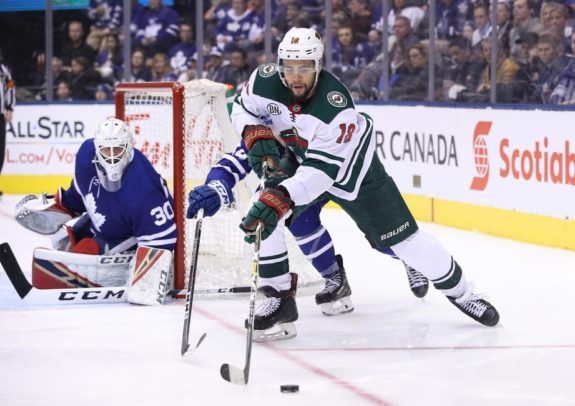After a promising rookie season, Minnesota Wild forward Jordan Greenway looks poised to become the team’s big-man and long-term physical presence. Greenway has the skill, the size, and the determination to be an important part of the Wild’s forward core for a long time, and in his rookies season, he showed glimpses of greatness. Greenway finished the season with 24 points (12 goals, 12 assists), which was ninth-most on the team.

Although 24 points does not sound like anything special for a top rookie, Greenway was a second-round pick, playing on the third line for most of the year on a defensive-minded team with rotating line-mates. When Charlie Coyle was traded to Boston at the trade deadline, the role of skilled power forward was passed down to Greenway (sorry Marcus Foligno, you are the enforcer). Greenway is not a goon or a regular fighter, but he has the grit, puck-skills, and size necessary to embody the new type of dominant power forward in today’s NHL.
Charlie Coyle’s High Expectations
Charlie Coyle never developed into the scoring power forward the Wild thought he would become. When the Wild received Coyle as part of the return package for Brent Burns (also including Devin Setoguchi), expectations were high for the former first-round pick. Although when the Wild traded Burns he was not the top-five defenseman he is today, he was still a very talented player — coming off a season with 46 points. Coyle was under pressure to make this trade a win (or at least a tie) for the Wild, and Setoguchi’s declining production did not help alleviate this pressure. This is possibly why Coyle seemed to get into his own head and get stuck in long slumps with the Wild. At the time of the Burns trade, Coyle was considered a top prospect, and the Wild were hoping he would turn into a productive power forward with his big frame (6-foot-3, 220-pounds).
Coyle’s Inconsistency with the Wild
However, Coyle never lived up to these expectations with Minnesota. His biggest problem was inconsistency: Occasionally he would look dominant, use his skill/hands to produce, and was noticeable on the ice. But most of the time, Coyle blended in, he was hesitant to shoot the puck and crash the net, and he did not use his big frame to his advantage. To be a good power forward in today’s NHL, you need to not only have skill and size, but use them effectively to drive the net and win battles in the corners.

Coyle did not seem to possess the determination or heart to use his size to his advantage, and this was the reason why he never developed into the dominant power forward the Wild needed so badly. The Wild drafted Greenway because of his size, his skill, and his ability to use his frame effectively, and from what he displayed in the NHL, in college, and in international competitions, he has a ton of potential.
Jordan Greenway Effectively Uses His Size
From what we have seen so far, Jordan Greenway has the skill, size (6-foot-6, 227-pounds), and most importantly, the determination necessary to eventually be a top power forward in the NHL. Looking at the NHL’s best pure power forwards right now (Matthew Tkachuk, Ryan Reaves, Tom Wilson, Mark Stone, Anders Lee, Ryan Getzlaf, Wayne Simmons, and Jamie Benn), they all have the heart to battle in front of the net and get rebounds, the ability to win loose pucks in the dirty areas of the ice, and they know how to use their big bodies to their advantage.
The bottom line is that Greenway has shown the ability to do these things, while Coyle proved that he could/would not use his frame to get into the dirty areas of the ice on a consistent basis.
Not Just a Net-Front Presence
To be a dominant power forward in today’s NHL, you not only have to drive the net and score “garbage goals,” you also have to be a competent playmaker, defender, and have some puck skills. Not only can Greenway score goals in front of the net, but he also has a dangerous wrist shot and is a surprisingly good skater. He finished the season with the fourth-best shooting percentage out of the Wild’s starters (11%). Greenway’s time on the ice per game also increased more than three minutes over the course of the season, demonstrating the coaches’ increased confidence in him.
Increased consistency should benefit him as well in his second season. Early in the season, the Wild moved Greenway to left wing from his natural center position. Greenway started playing better after this position change, and the Wild expect to keep him at wing for the upcoming season. As Greenway improves upon his positioning and defensive responsibilities as a wing, look for his game to improve this year and his plus-minus to increase.
Greenway Has Experience in Big Games
Greenway has excelled in many pressure situations during high-stakes games so far in his career. He won the gold medal for both the 2014 US U-17 team at the World Hockey Challenge and the 2015 US U-18 team at the IIHF World Championships; he played at the 2017 IIHF World Championships and for the US at the 2018 Olympics; and while at Boston University, he scored 92 points in 112 games. In 2018 Greenway was a semi-finalist for the Walter Brown Award (New England’s best college hockey player), he was voted on the NCAA Northeast Regional All-Tournament Team, and he was a member of the Hockey East All-Tournament Team.
In 2018, Jordan Greenway became the first player ever to compete in the NCAA Tournament, the Stanley Cup Playoffs, and the Olympics in one season. Greenway also scored his first NHL goal in the 2018 NHL Playoffs in a crucial game against the Winnipeg Jets. Although Greenway might not be the a flashy, highly rated player, he provides great value for a second round draft pick, and he has the potential to become the dominant power forward for which the Minnesota Wild have been searching.